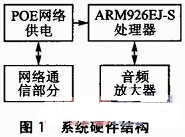This paper presents a network broadcast design scheme for an embedded system based on ARM and PoE. The solution uses the ARM926EJ-S processor and its peripheral modules as the hardware platform and embedded Linux as the operating system to form the entire system. The system uses Ethernet power supply to realize the function of network broadcasting, without the need for special power supply lines.
1 System structure
The system consists of audio amplifier LM48510, audio processor, power over Ethernet and Ethernet data communication. From the front end to the back end, it passes through several processing procedures such as audio amplifier M48510 → ARM926EJ-S → PoE / Network to realize the network broadcast of power over Ethernet. The hardware structure of the system is shown in Figure 1.

2 System hardware design
2.1 ARM926EJ-S related design
The ARM926EJ-S processor is a member of the general-purpose microprocessor ARM9 family and belongs to the 5TEJ version of the ARM architecture. For multi-tasking applications, full memory management, high performance, small core size and low power consumption are all important features. The ARM926EJ-S processor supports the 32-bit ARM 16-bit Thumb instruction set, enabling users to achieve a balance between high performance and high code density. Apply the solution of ARM-926EJ-S soft core processor to create a configurable buffer storage system with comprehensive functions, and enhance the core to meet the needs of consumer electronics such as audio / video, voice and multimedia.
ARM926EJ-S as the CPU of the system, captures the audio signal of the microphone, realizes the digital audio signal through the audio signal processor, and finishes the encoding process, then DMA to the external SDRAM through the AHB bus. After related processing by the audio amplifier LM48510, it is sent to Ethernet MAC for output from the network port and sent to the speaker. In addition, ARM926EJ-S has a wealth of peripherals and I / O, which also provides great convenience for future system upgrades.
2.2 PoE power design
2.2.1 The working process of PoE power supply
First, the PSE device outputs a small voltage at the port until it detects that the connection of the cable terminal is a power receiving device that supports the IEEE 802.3af standard. After detecting the PD of the power receiving device, the PSE device may classify the PD device and evaluate the power loss required by the PD device. During a start-up period of configurable time (generally less than 15μs), the PSE device starts to supply power to the PD device from a low voltage until it provides 48 V DC power. Provide stable and reliable direct current of 48 V for PD devices to meet the power consumption of PD devices not exceeding 15.4 W. If the PD device is disconnected from the network, the PSE will quickly (generally within 300 to 400 ms) stop powering the PD device and repeat the detection process to detect whether the cable terminal is connected to the PD device. The schematic diagram of POE power supply is shown in Figure 2.

2.2.2 Power over Ethernet controller LTC4267
Linear Technology introduced the IEEE 802.3af Power over Ethernet (PoE) controller LTC4267, which has an integrated switching regulator, which greatly simplifies the design of powered devices (PD). The LTC4267 includes a constant frequency current mode on-chip DC / DC controller, which is easily customized to meet the requirements of multiple power supply voltages and load currents. Constant frequency operation can be maintained under very light load conditions, thereby minimizing the low frequency noise generated.
3 System software design
The software system includes a system boot program Bootloader, an embedded operating system and upper application programs. Bootloader is the boot program that runs before the operating system. The main task is to complete the necessary hardware initialization and operating system loading before system startup; the operating system is the core program of the entire embedded platform. The main function is to efficiently manage and allocate the underlying hardware resources , And provide system call interfaces that are independent of hardware details for upper-layer applications.
The system initialization program also needs to complete the system's network allocation, audio-related parameter configuration, and close unused peripherals to reduce power consumption as much as possible.
The software system also includes key TCP / IP and UDP protocol libraries for network broadcasting. Application software includes file system management, network services, mail sending, file transfer, detection and alarm. The network service program finishes sending voice to a certain port of the network for other network devices to access.
Conclusion
This article introduces the design and implementation of network broadcasting with ARM926EJ-S microcontroller as the core. The network power supply module LTCA267 is an on-chip DC / DC controller with constant frequency current mode. The audio amplifier LM48510 does not require an external boost converter. It can ensure that the output power of new products remains stable. At present, ARM926EJ-S has a wide range of applications in consumer electronics such as audio / video, voice and multimedia. Therefore, the system has broad application prospects.
Ac Linear Actuator,Miniature Linear Actuators,24V Linear Actuator,Mini Linear Actuator
Changzhou Sherry International Trading Co., Ltd. , https://www.sherry-motor.com